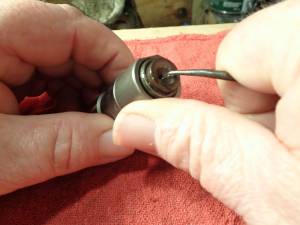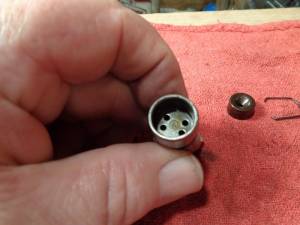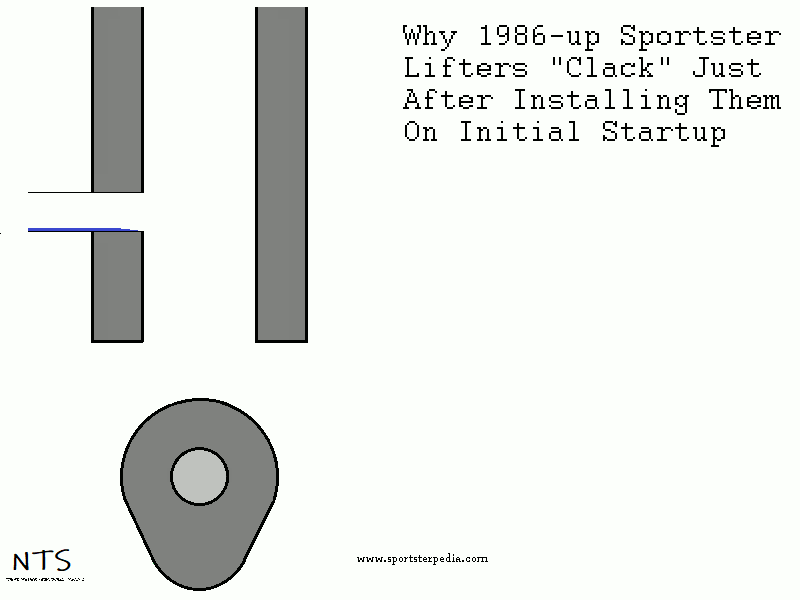EVO: Engine Mechanicals - Sub-02D
Why 1986-up Lifters Clack on Initial Startup
Click Here to reference the Mechanical and Hydraulic Operation of these lifters in the Sportsterpedia.
The quick answer is it just takes a little time for system oil pressure to make it inside the lower pressure chamber of the lifters to pump them up.
This is quite normal on fresh builds and does tend to scare one that isn't looking for it.
This is can also happen if your bike has been stored for a while as most of the oil will be drained down.
On assembly, the act of installing the rocker boxes will bleed each lifter down to a low oil state.
So even if you do have the lifter fully pumped before installing it, it won't be that way when you fire up the engine.
In fact, they will all be low of oil and most likely will bang at such a rate to sound like they are about to come out of there.
On older type lifters one could stick a thin rod thru the center of the lifter down to the check valve and open it to bleed off pressure / air.
But with these having the flat disc under the pushrod cup, a thin rod stops at the restriction disc.
Oil has to go around the disc thru metered holes before it can get into the reservoir.
First oil would travel down the pushrod tube and just seep past the tiny restricted hole on bottom of the pushrod cup to get to the restriction disc underneath it.
Oil is pressurized in operation to get past the designed restriction in the pushrod cup / restriction disc.
Therefore oil has to be pressurized from the top to get past the restriction in reverse.
Either way, the oil would need pressure behind it to open the check disc below the reservoir in order to get into the pressure chamber in the bottom.
All that would do is fill the pushrods thus the oil reservoir above the check valve (if oil can make it past the restricted disc under the pushrods.
When installing lifters in the motor, it's best to make sure each one is fully pumped up (full of oil and plungers holding tight, not spongy).
This will ensure each lifter WILL pump up and is not faulty (bad thing to learn on a too late notice).
Some say to soak the lifters in a container of oil overnight.
Others will dunk each lifter in a container of oil working the plunger up and down until it doesn't move down at all (faster and more accurate anyway).
However, it's done, the important thing is to lube to rollers of the wheels good and insure there is at least (some) oil inside the lifter body.
The butt squeezing “did I just ruin my motor” feeling is normal as long as the clacking noise soon goes away.
Once oil pressure finds it's way into the lower pressure chamber in the lifter (not just to the lifter feed hole), lifters will pump up and the noise goes away.
It shouldn't take too long for oil to arrive and pump the lifters up (normally between 1 and 5 minutes has been reported on the XLForum).
It would depend on how thick oil viscosity is and how long it takes the oil pump to get the system pressurized.
It also may depend on how much clearance is between each lifter body and it's individual plunger.
There is a video on YouTube from S&S Cycle comparing their lifter oil delivery time to GM lifters when used in Harleys.
This video does not open up the lifter for comparison however as they use a test rig and measure oil delivery timing on fire-up.
But there is more information needed and the video doesn't go into a lot of detail.
Click on this link to view the video.
You can't pour oil down the pushrod tubes and fill the lifter's lower pressure chamber.
That won't do as much good as adding assembly lube to the rocker arms / shafts and bushings before buttoning up.
That gives needed lube to the moving parts whilst waiting for the lifters to pump up fully and send oil up there.
You can pre-fill the lifters that way but that oil may just drain to the cam chest before the motor is fired up.
Oil needs to completely fill the lower chamber and purge any air that is in there (not the reservoir above).
Pouring oil down the pushrod tubes may or may not fill the plunger reservoir due to the restricted disc under the pushrod cup.
But even if you could fill the reservoir, it's above the check valve that needs downward pressure to open and let oil come in from the reservoir.
And installing the lifters will bleed that down anyway.
You can see the restriction disc below that buttons up against the bottom of the pushrod cup.
Also, check the link at the top of the page to view more information on how these lifters operate.
Oil flows slow when not at operating temp (when you would hear the clacking as mentioned), slower when at room temp, slower in cold weather etc.
So how long the lifters will bark will most likely be different on each bike / situation.
Expect seconds to a few minutes and don't wind up the motor until the lifters quiet down.
If they are noisy, cracking the throttle won't get oil to the lifters as fast as the lifters rattle around.
The animation below runs from lifter installation to firing up the engine showing the different stages the pressure chamber goes through during a build.
The pressure chamber is the lower compartment under the check valve and is responsible for actually lifting the engine valves.
The inner plunger oil reservoir is above the check valve and most likely will not run out of oil (holds app 30% more oil than the lower chamber).
But the plunger will hit it's hard seat anyways when the oil level in the lower chamber gets too low and/or is infiltrated with air.



